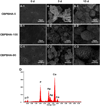Synthesis and characterization of biomimetic citrate-based biodegradable composites
- PMID: 23996976
- PMCID: PMC3931750
- DOI: 10.1002/jbm.a.34928
Synthesis and characterization of biomimetic citrate-based biodegradable composites
Abstract
Natural bone apatite crystals, which mediate the development and regulate the load-bearing function of bone, have recently been associated with strongly bound citrate molecules. However, such understanding has not been translated into bone biomaterial design and osteoblast cell culture. In this work, we have developed a new class of biodegradable, mechanically strong, and biocompatible citrate-based polymer blends (CBPBs), which offer enhanced hydroxyapatite binding to produce more biomimetic composites (CBPBHAs) for orthopedic applications. CBPBHAs consist of the newly developed osteoconductive citrate-presenting biodegradable polymers, crosslinked urethane-doped polyester and poly (octanediol citrate), which can be composited with up to 65 wt % hydroxyapatite. CBPBHA networks produced materials with a compressive strength of 116.23 ± 5.37 MPa comparable to human cortical bone (100-230 MPa), and increased C2C12 osterix gene and alkaline phosphatase gene expression in vitro. The promising results above prompted an investigation on the role of citrate supplementation in culture medium for osteoblast culture, which showed that exogenous citrate supplemented into media accelerated the in vitro phenotype progression of MG-63 osteoblasts. After 6 weeks of implantation in a rabbit lateral femoral condyle defect model, CBPBHA composites elicited minimal fibrous tissue encapsulation and were well integrated with the surrounding bone tissues. The development of citrate-presenting CBPBHA biomaterials and preliminary studies revealing the effects of free exogenous citrate on osteoblast culture shows the potential of citrate biomaterials to bridge the gap in orthopedic biomaterial design and osteoblast cell culture in that the role of citrate molecules has previously been overlooked.
Keywords: biodegradable composites; bone tissue engineering; citric acid; osterix.
© 2013 Wiley Periodicals, Inc.
Figures








Similar articles
-
Development of osteopromotive poly (octamethylene citrate glycerophosphate) for enhanced bone regeneration.Acta Biomater. 2019 Jul 15;93:180-191. doi: 10.1016/j.actbio.2019.03.050. Epub 2019 Mar 27. Acta Biomater. 2019. PMID: 30926580 Free PMC article.
-
A strong, tough, and osteoconductive hydroxyapatite mineralized polyacrylamide/dextran hydrogel for bone tissue regeneration.Acta Biomater. 2019 Apr 1;88:503-513. doi: 10.1016/j.actbio.2019.02.019. Epub 2019 Feb 14. Acta Biomater. 2019. PMID: 30772515
-
Synthesis, characterization, and biocompatibility of a novel biomimetic material based on MGF-Ct24E modified poly(D, L-lactic acid).J Biomed Mater Res A. 2012 Dec;100(12):3496-502. doi: 10.1002/jbm.a.34276. Epub 2012 Aug 31. J Biomed Mater Res A. 2012. PMID: 22941771
-
Citrate chemistry and biology for biomaterials design.Biomaterials. 2018 Sep;178:383-400. doi: 10.1016/j.biomaterials.2018.05.003. Epub 2018 May 4. Biomaterials. 2018. PMID: 29759730 Free PMC article. Review.
-
Design strategies and applications of nacre-based biomaterials.Acta Biomater. 2017 May;54:21-34. doi: 10.1016/j.actbio.2017.03.003. Epub 2017 Mar 6. Acta Biomater. 2017. PMID: 28274766 Review.
Cited by
-
A functional analysis of a resorbable citrate-based composite tendon anchor.Bioact Mater. 2024 Jul 22;41:207-220. doi: 10.1016/j.bioactmat.2024.06.030. eCollection 2024 Nov. Bioact Mater. 2024. PMID: 39149596 Free PMC article.
-
Evaluation of cytotoxicity of 3.8 % SDF and BioAKT solutions on the viability of dental pulp stem cells.J Oral Biol Craniofac Res. 2024 Jan-Feb;14(1):86-91. doi: 10.1016/j.jobcr.2024.01.001. Epub 2024 Jan 11. J Oral Biol Craniofac Res. 2024. PMID: 38293570 Free PMC article.
-
Development of Biodegradable Osteopromotive Citrate-Based Bone Putty.Small. 2022 Sep;18(36):e2203003. doi: 10.1002/smll.202203003. Epub 2022 Jun 19. Small. 2022. PMID: 35717669 Free PMC article.
-
Study on the Antimicrobial Properties of Citrate-Based Biodegradable Polymers.Front Bioeng Biotechnol. 2014 Jul 3;2:23. doi: 10.3389/fbioe.2014.00023. eCollection 2014. Front Bioeng Biotechnol. 2014. PMID: 25023605 Free PMC article.
-
Citrate-based materials fuel human stem cells by metabonegenic regulation.Proc Natl Acad Sci U S A. 2018 Dec 11;115(50):E11741-E11750. doi: 10.1073/pnas.1813000115. Epub 2018 Nov 26. Proc Natl Acad Sci U S A. 2018. PMID: 30478052 Free PMC article.
References
Publication types
MeSH terms
Substances
Grants and funding
LinkOut - more resources
Full Text Sources
Other Literature Sources
Miscellaneous

